warning light RENAULT TWINGO 2017 3.G Workshop Manual
[x] Cancel search | Manufacturer: RENAULT, Model Year: 2017, Model line: TWINGO, Model: RENAULT TWINGO 2017 3.GPages: 228, PDF Size: 6.76 MB
Page 128 of 228
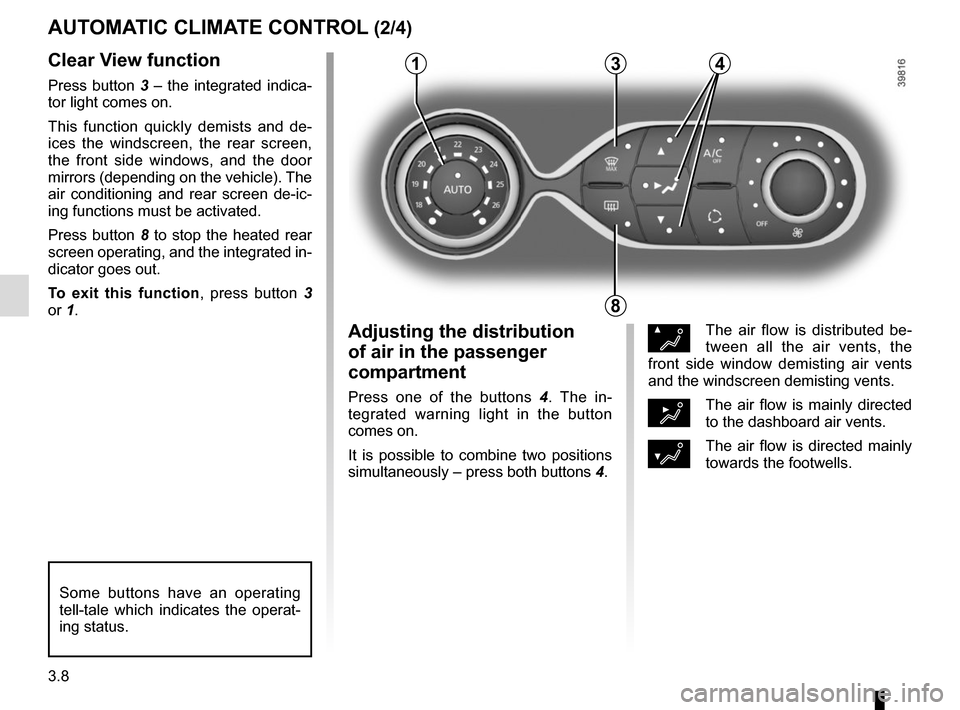
3.8
Clear View function
Press button 3 – the integrated indica-
tor light comes on.
This function quickly demists and de-
ices the windscreen, the rear screen,
the front side windows, and the door
mirrors (depending on the vehicle). The
air conditioning and rear screen de-ic-
ing functions must be activated.
Press button 8 to stop the heated rear
screen operating, and the integrated in-
dicator goes out.
To exit this function, press button 3
or 1.
AUTOMATIC CLIMATE CONTROL (2/4)
ØThe air flow is distributed be-
tween all the air vents, the
front side window demisting air vents
and the windscreen demisting vents.
½The air flow is mainly directed
to the dashboard air vents.
¿The air flow is directed mainly
towards the footwells.
Adjusting the distribution
of air in the passenger
compartment
Press one of the buttons 4 . The in-
tegrated warning light in the button
comes on.
It is possible to combine two positions
simultaneously – press both buttons 4.
8
3
Some buttons have an operating
tell-tale which indicates the operat-
ing status.
14
Page 130 of 228
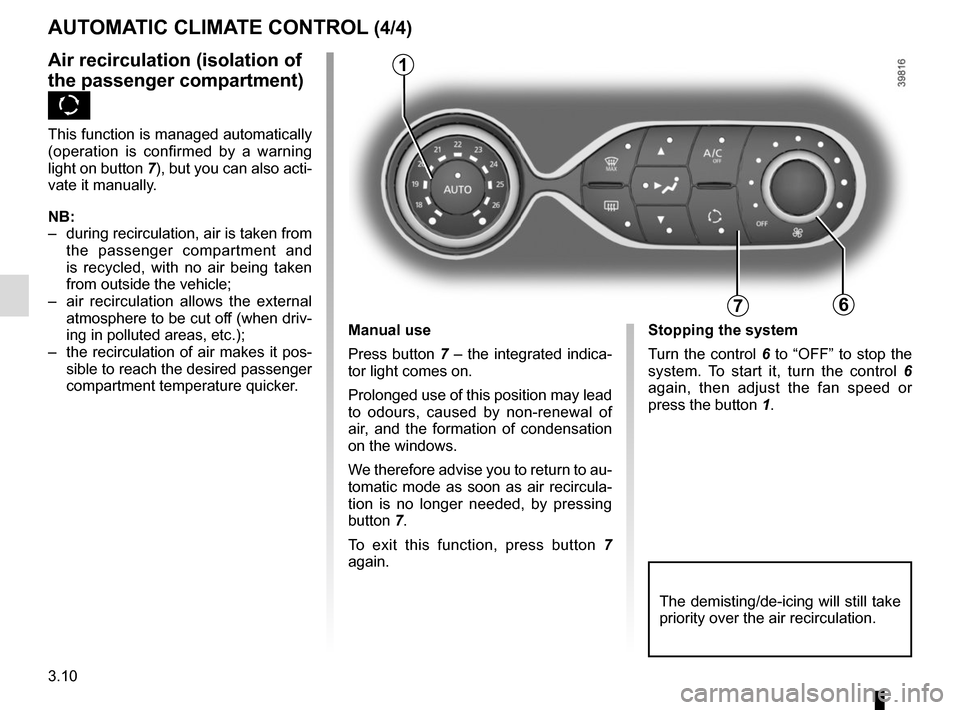
3.10
AUTOMATIC CLIMATE CONTROL (4/4)
76
Air recirculation (isolation of
the passenger compartment)
K
This function is managed automatically
(operation is confirmed by a warning
light on button 7), but you can also acti-
vate it manually.
NB:
– during recirculation, air is taken from the passenger compartment and
is recycled, with no air being taken
from outside the vehicle;
– air recirculation allows the external atmosphere to be cut off (when driv-
ing in polluted areas, etc.);
– the recirculation of air makes it pos- sible to reach the desired passenger
compartment temperature quicker.
1
The demisting/de-icing will still take
priority over the air recirculation.
Manual use
Press button 7 – the integrated indica-
tor light comes on.
Prolonged use of this position may lead
to odours, caused by non-renewal of
air, and the formation of condensation
on the windows.
We therefore advise you to return to au-
tomatic mode as soon as air recircula-
tion is no longer needed, by pressing
button 7.
To exit this function, press button 7
again. Stopping the system
Turn the control 6 to “OFF” to stop the
system. To start it, turn the control
6
again, then adjust the fan speed or
press the button 1.
Page 162 of 228
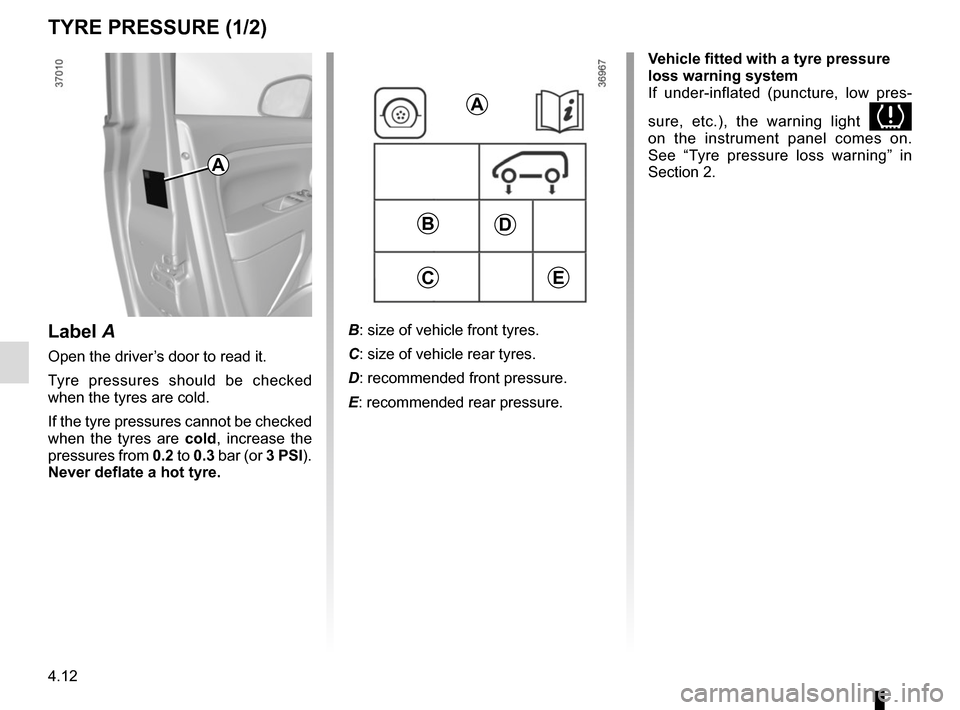
4.12
TYRE PRESSURE (1/2)
B: size of vehicle front tyres.
C: size of vehicle rear tyres.
D: recommended front pressure.
E: recommended rear pressure.
A
D
E
B
C
Label A
Open the driver’s door to read it.
Tyre pressures should be checked
when the tyres are cold.
If the tyre pressures cannot be checked
when the tyres are cold, increase the
pressures from 0.2 to 0.3 bar (or 3 PSI).
Never deflate a hot tyre.
A
Vehicle fitted with a tyre pressure
loss warning system
If under-inflated (puncture, low pres-
sure, etc.), the warning light
on the instrument panel comes on.
See “Tyre pressure loss warning” in
Section 2.
Page 171 of 228
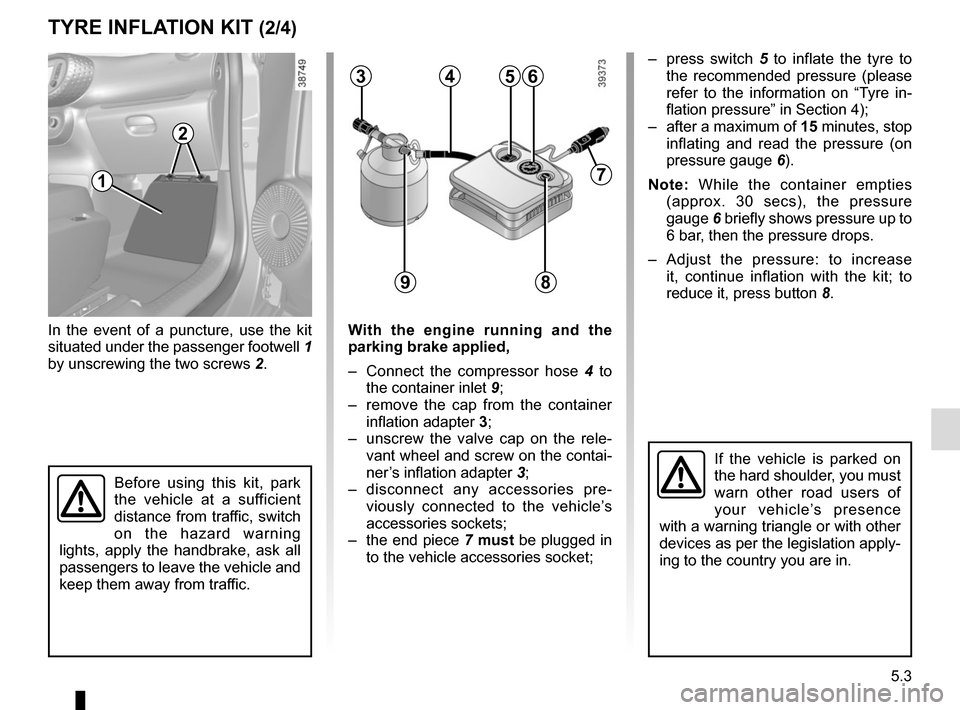
5.3
TYRE INFLATION KIT (2/4)
In the event of a puncture, use the kit
situated under the passenger footwell 1
by unscrewing the two screws 2.With the engine running and the
parking brake applied,
– Connect the compressor hose 4 to
the container inlet 9;
– remove the cap from the container inflation adapter 3;
– unscrew the valve cap on the rele- vant wheel and screw on the contai-
ner’s inflation adapter 3;
– disconnect any accessories pre- viously connected to the vehicle’s
accessories sockets;
– the end piece 7 must be plugged in
to the vehicle accessories socket;
563
Before using this kit, park
the vehicle at a sufficient
distance from traffic, switch
on the hazard warning
lights, apply the handbrake, ask all
passengers to leave the vehicle and
keep them away from traffic.
9
If the vehicle is parked on
the hard shoulder, you must
warn other road users of
your vehicle’s presence
with a warning triangle or with other
devices as per the legislation apply-
ing to the country you are in.
– press switch 5 to inflate the tyre to
the recommended pressure (please
refer to the information on “Tyre in-
flation pressure” in Section 4);
– after a maximum of 15 minutes, stop inflating and read the pressure (on
pressure gauge 6).
Note: While the container empties (approx. 30 secs), the pressure
gauge 6 briefly shows pressure up to
6 bar, then the pressure drops.
– Adjust the pressure: to increase it, continue inflation with the kit; to
reduce it, press button 8.
7
4
8
1
2
Page 175 of 228
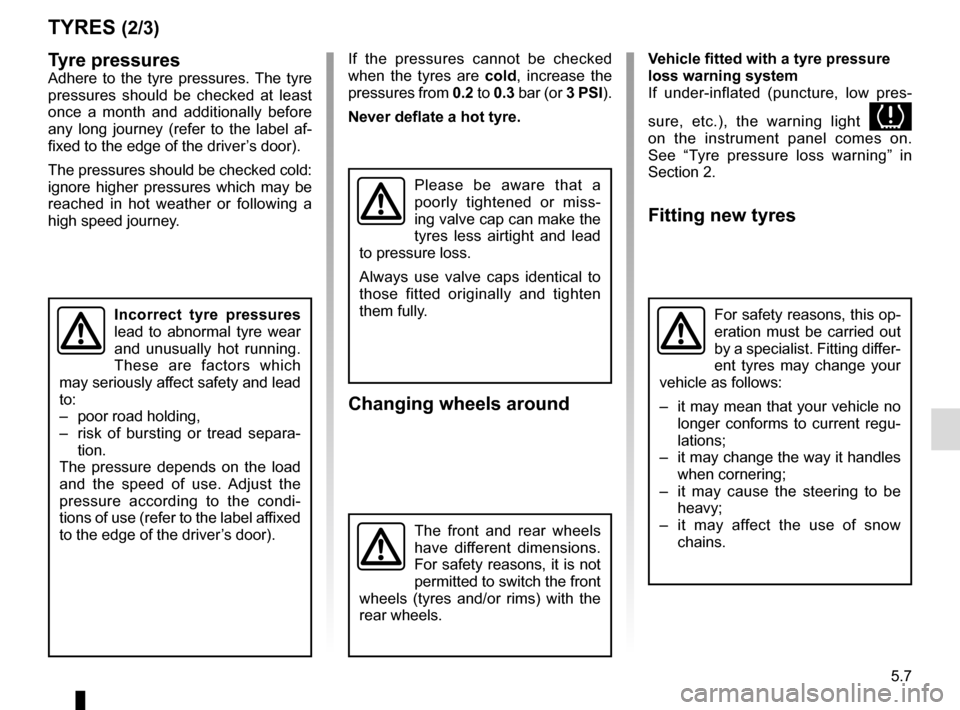
5.7
Tyre pressuresAdhere to the tyre pressures. The tyre
pressures should be checked at least
once a month and additionally before
any long journey (refer to the label af-
fixed to the edge of the driver’s door).
The pressures should be checked cold:
ignore higher pressures which may be
reached in hot weather or following a
high speed journey.Vehicle fitted with a tyre pressure
loss warning system
If under-inflated (puncture, low pres-
sure, etc.), the warning light
on the instrument panel comes on.
See “Tyre pressure loss warning” in
Section 2.
Fitting new tyres
For safety reasons, this op-
eration must be carried out
by a specialist. Fitting differ-
ent tyres may change your
vehicle as follows:
– it may mean that your vehicle no longer conforms to current regu-
lations;
– it may change the way it handles when cornering;
– it may cause the steering to be heavy;
– it may affect the use of snow chains.
If the pressures cannot be checked
when the tyres are cold, increase the
pressures from 0.2 to 0.3 bar (or 3 PSI).
Never deflate a hot tyre.
Changing wheels around
TYRES (2/3)
Please be aware that a
poorly tightened or miss-
ing valve cap can make the
tyres less airtight and lead
to pressure loss.
Always use valve caps identical to
those fitted originally and tighten
them fully.
Incorrect tyre pressures
lead to abnormal tyre wear
and unusually hot running.
These are factors which
may seriously affect safety and lead
to:
– poor road holding,
– risk of bursting or tread separa- tion.
The pressure depends on the load
and the speed of use. Adjust the
pressure according to the condi-
tions of use (refer to the label affixed
to the edge of the driver’s door).
The front and rear wheels
have different dimensions.
For safety reasons, it is not
permitted to switch the front
wheels (tyres and/or rims) with the
rear wheels.
Page 194 of 228
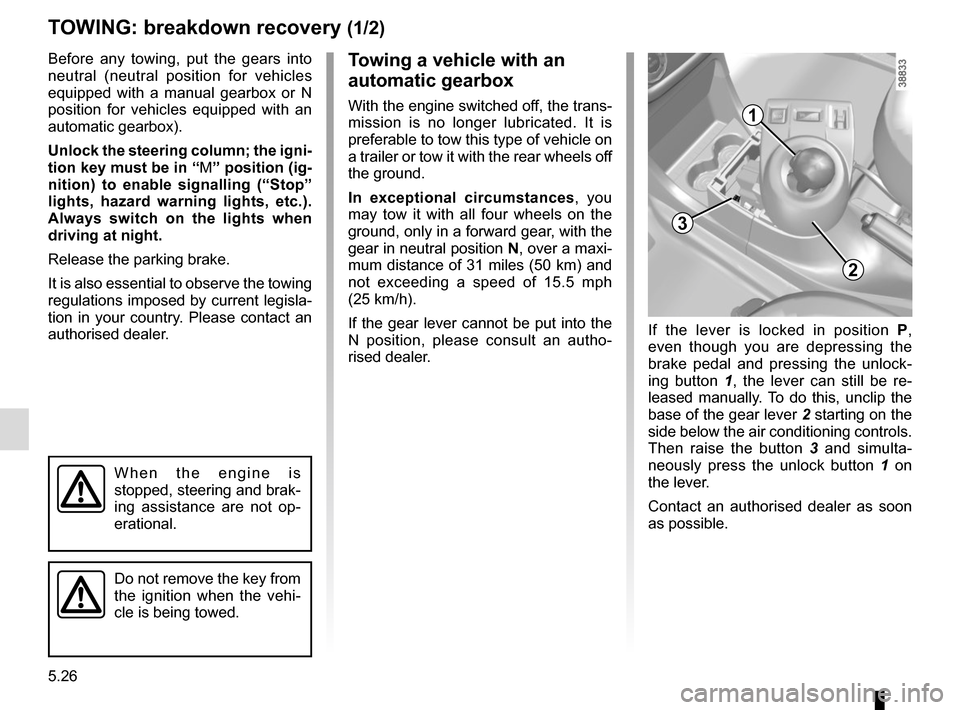
5.26
TOWING: breakdown recovery (1/2)
Towing a vehicle with an
automatic gearbox
With the engine switched off, the trans-
mission is no longer lubricated. It is
preferable to tow this type of vehicle on
a trailer or tow it with the rear wheels off
the ground.
In exceptional circumstances, you
may tow it with all four wheels on the
ground, only in a forward gear, with the
gear in neutral position N, over a maxi-
mum distance of 31 miles (50 km) and
not exceeding a speed of 15.5 mph
(25 km/h).
If the gear lever cannot be put into the
N position, please consult an autho-
rised dealer.1
2
Before any towing, put the gears into
neutral (neutral position for vehicles
equipped with a manual gearbox or N
position for vehicles equipped with an
automatic gearbox).
Unlock the steering column; the igni-
tion key must be in “ M” position (ig-
nition) to enable signalling (“Stop”
lights, hazard warning lights, etc.).
Always switch on the lights when
driving at night.
Release the parking brake.
It is also essential to observe the towing
regulations imposed by current legisla-
tion in your country. Please contact an
authorised dealer.
When the engine is
stopped, steering and brak-
ing assistance are not op-
erational.
Do not remove the key from
the ignition when the vehi-
cle is being towed.
3
If the lever is locked in position P ,
even though you are depressing the
brake pedal and pressing the unlock-
ing button 1 , the lever can still be re-
leased manually. To do this, unclip the
base of the gear lever 2 starting on the
side below the air conditioning controls.
Then raise the button 3 and simulta-
neously press the unlock button 1 on
the lever.
Contact an authorised dealer as soon
as possible.
Page 198 of 228
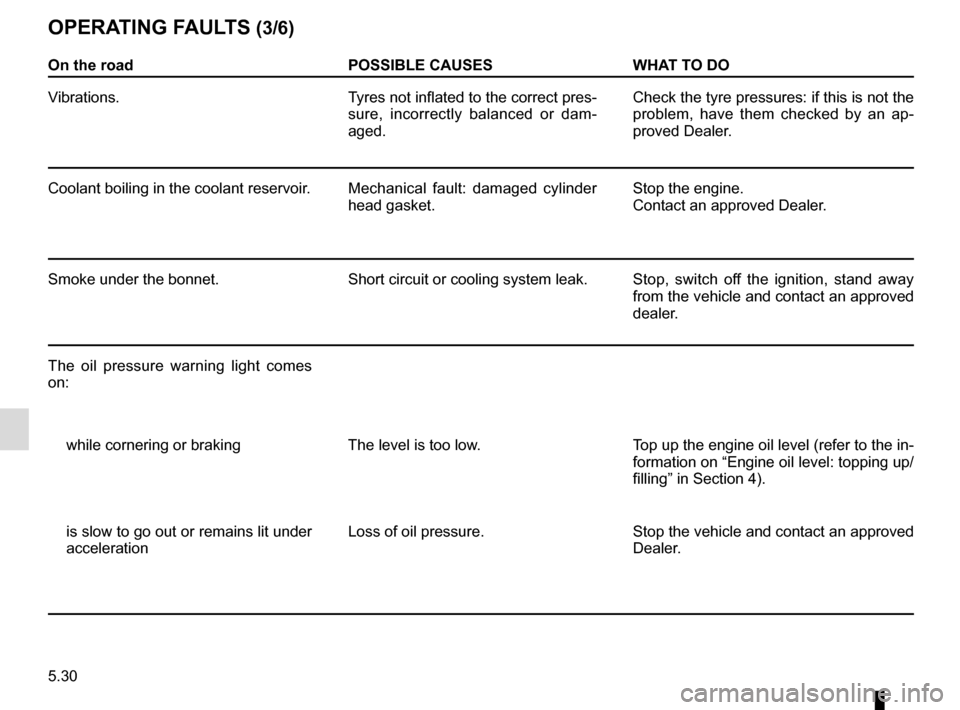
5.30
On the roadPOSSIBLE CAUSESWHAT TO DO
Vibrations. Tyres not inflated to the correct pres-
sure, incorrectly balanced or dam-
aged. Check the tyre pressures: if this is not the
problem, have them checked by an ap-
proved Dealer.
Coolant boiling in the coolant reservoir. Mechanical fault: damaged cylinder
head gasket.Stop the engine.
Contact an approved Dealer.
Smoke under the bonnet. Short circuit or cooling system leak.Stop, switch off the ignition, stand away
from the vehicle and contact an approved
dealer.
The oil pressure warning light comes
on:
while cornering or braking The level is too low. Top up the engine oil level (refer to the in-
formation on “Engine oil level: topping up/
filling” in Section 4).
is slow to go out or remains lit under
acceleration Loss of oil pressure.
Stop the vehicle and contact an approved
Dealer.
OPERATING FAULTS (3/6)
Page 222 of 228
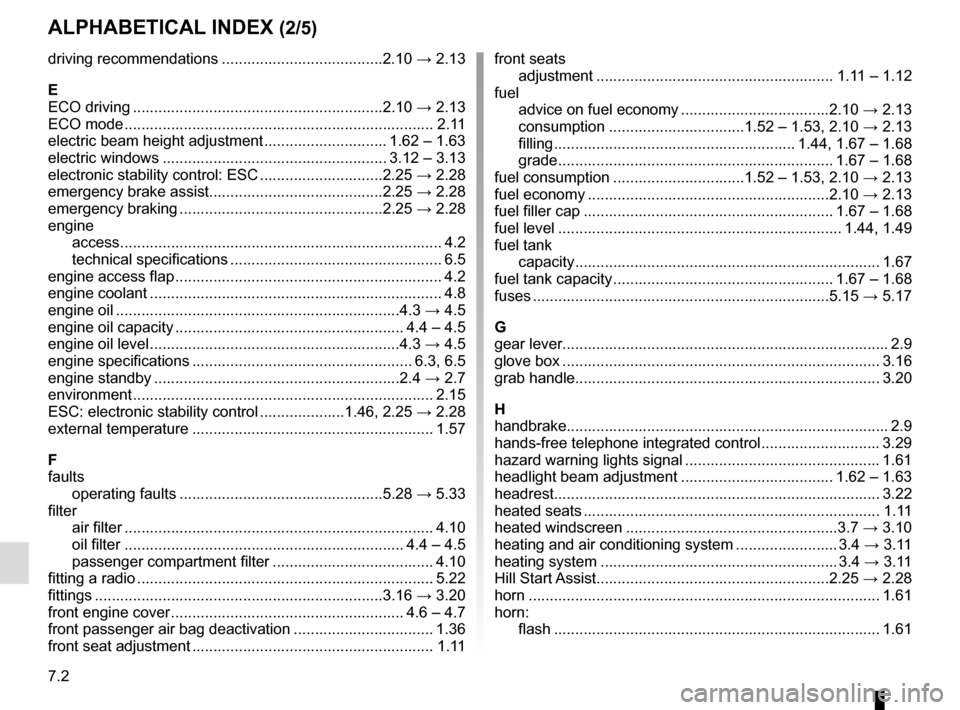
7.2
ALPHABETICAL INDEX (2/5)
driving recommendations ......................................2.10 → 2.13
E
ECO driving ...........................................................2.10 → 2.13
ECO mode ........................................................................\
. 2.11
electric beam height adjustment ............................. 1.62 – 1.63
electric windows ..................................................... 3.12 – 3.13
electronic stability control: ESC .............................2.25 → 2.28
emergency brake assist.........................................2.25 → 2.28
emergency braking ................................................2.25 → 2.28
engine access .................................................................\
........... 4.2
technical specifications .................................................. 6.5
engine access flap ............................................................... 4.2
engine coolant ..................................................................... 4.8
engine oil ...................................................................4.3 → 4.5
engine oil capacity ...................................................... 4.4 – 4.5
engine oil level ...........................................................4.3 → 4.5
engine specifications .................................................... 6.3, 6.5
engine standby ..........................................................2.4 → 2.7
environment ............................................................\
........... 2.15
ESC: electronic stability control ....................1.46, 2.25 → 2.28
external temperature ......................................................... 1.57
F
faults operating faults ................................................5.28 → 5.33
filter air filter ........................................................................\
. 4.10
oil filter .................................................................. 4.4 – 4.5
passenger compartment filter ...................................... 4.10
fitting a radio ...................................................................... 5.22
fittings ...............................................................\
.....3.16 → 3.20
front engine cover ....................................................... 4.6 – 4.7
front passenger air bag deactivation ................................. 1.36
front seat adjustment ......................................................... 1.11 front seats
adjustment ........................................................ 1.11 – 1.12
fuel advice on fuel economy ...................................2.10 → 2.13
consumption ................................1.52 – 1.53, 2.10 → 2.13
filling ......................................................... 1.44, 1.67 – 1.68
grade ................................................................. 1.67 – 1.68
fuel consumption ...............................1.52 – 1.53, 2.10 → 2.13
fuel economy .........................................................2.10 → 2.13
fuel filler cap ........................................................... 1.67 – 1.68
fuel level ................................................................... 1.44, 1.49
fuel tank capacity ...............................................................\
......... 1.67
fuel tank capacity .................................................... 1.67 – 1.68
fuses ..................................................................\
....5.15 → 5.17
G
gear lever........................................................................\
..... 2.9
glove box ........................................................................\
... 3.16
grab handle........................................................................\
3.20
H
handbrake........................................................................\
.... 2.9
hands-free telephone integrated control ............................ 3.29
hazard warning lights signal .............................................. 1.61
headlight beam adjustment .................................... 1.62 – 1.63
headrest........................................................................\
..... 3.22
heated seats ...................................................................... 1.11
heated windscreen ..................................................3.7 → 3.10
heating and air conditioning system ........................ 3.4 → 3.11
heating system ........................................................ 3.4 → 3.11
Hill Start Assist.......................................................2.25 → 2.28
horn ...................................................................\
................ 1.61
horn: flash ..................................................................\
........... 1.61
Page 223 of 228
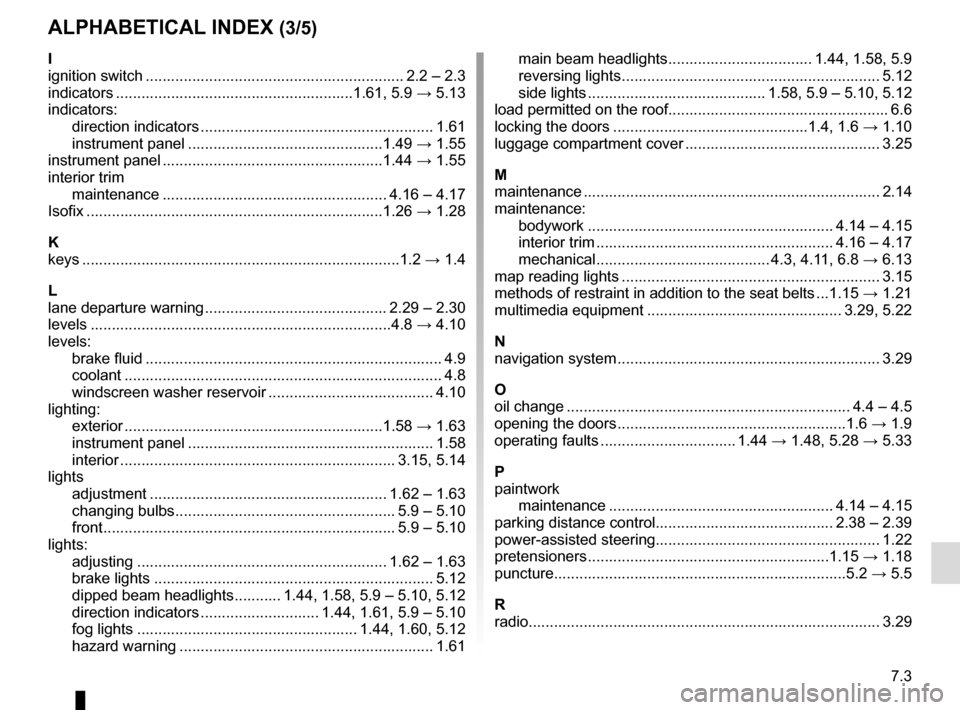
7.3
ALPHABETICAL INDEX (3/5)
I
ignition switch ............................................................. 2.2 – 2.3
indicators ........................................................1.61, 5.9 → 5.13
indicators: direction indicators ....................................................... 1.61
instrument panel ..............................................1.49 → 1.55
instrument panel ....................................................1.44 → 1.55
interior trim maintenance ..................................................... 4.16 – 4.17
Isofix .................................................................\
.....1.26 → 1.28
K
keys ...................................................................\
........1.2 → 1.4
L
lane departure warning ........................................... 2.29 – 2.30
levels .................................................................\
......4.8 → 4.10
levels: brake fluid ...................................................................... 4.9
coolant ................................................................\
........... 4.8
windscreen washer reservoir ....................................... 4.10
lighting: exterior .............................................................1.58 → 1.63
instrument panel .......................................................... 1.58
interior ...............................................................\
.. 3.15, 5.14
lights adjustment ........................................................ 1.62 – 1.63
changing bulbs .................................................... 5.9 – 5.10
front ..................................................................... 5.9 – 5.10
lights: adjusting ........................................................... 1.62 – 1.63
brake lights .................................................................. 5.12
dipped beam headlights ........... 1.44, 1.58, 5.9 – 5.10, 5.12
direction indicators ............................ 1.44, 1.61, 5.9 – 5.10
fog lights .................................................... 1.44, 1.60, 5.12
hazard warning ............................................................ 1.61 main beam headlights .................................. 1.44, 1.58, 5.9
reversing lights ............................................................. 5.12
side lights .......................................... 1.58, 5.9 – 5.10, 5.12
load permitted on the roof.................................................... 6.6
locking the doors ..............................................1.4, 1.6 → 1.10
luggage compartment cover .............................................. 3.25
M
maintenance ............................................................\
.......... 2.14
maintenance: bodywork .......................................................... 4.14 – 4.15
interior trim ........................................................ 4.16 – 4.17
mechanical ......................................... 4.3, 4.11, 6.8 → 6.13
map reading lights ............................................................. 3.15
methods of restraint in addition to the seat belts ...1.15 → 1.21
multimedia equipment .............................................. 3.29, 5.22
N
navigation system .............................................................. 3.29
O
oil change ................................................................... 4.4 – 4.5
opening the doors ......................................................1.6 → 1.9
operating faults ................................ 1.44 → 1.48, 5.28 → 5.33
P
paintwork maintenance ..................................................... 4.14 – 4.15
parking distance control.......................................... 2.38 – 2.39
power-assisted steering..................................................... 1.22
pretensioners .........................................................1.15 → 1.18
puncture.....................................................................5.2 → 5.5
R
radio........................................................................\
........... 3.29
Page 224 of 228
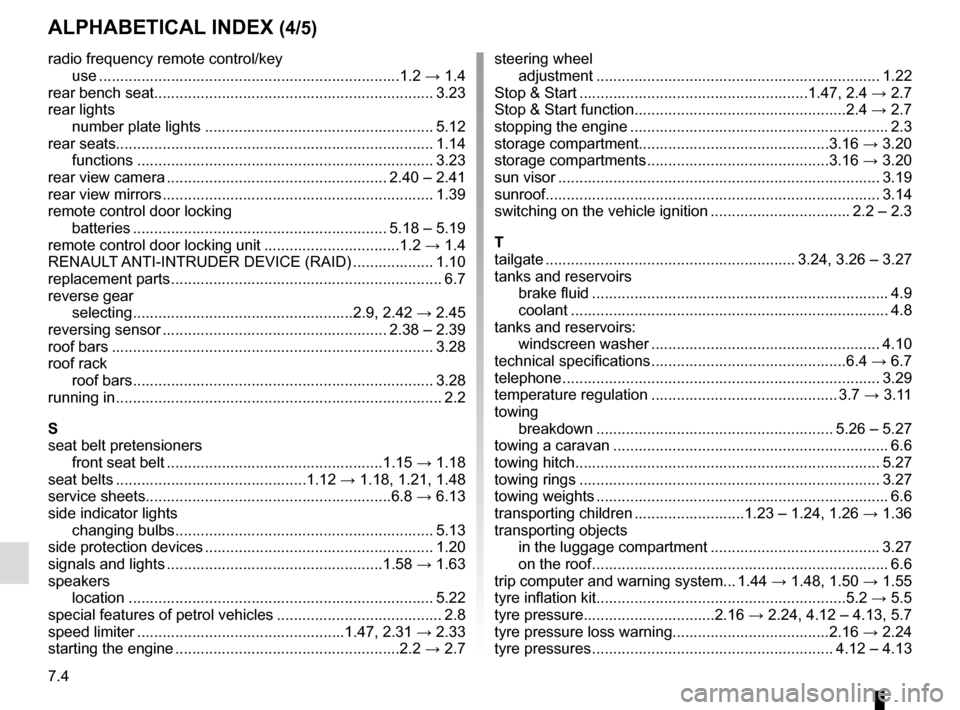
7.4
ALPHABETICAL INDEX (4/5)
radio frequency remote control/keyuse ....................................................................\
...1.2 → 1.4
rear bench seat.................................................................. 3.23
rear lights number plate lights ...................................................... 5.12
rear seats........................................................................\
... 1.14 functions ..............................................................\
........ 3.23
rear view camera .................................................... 2.40 – 2.41
rear view mirrors ................................................................ 1.39
remote control door locking batteries ............................................................ 5.18 – 5.19
remote control door locking unit ................................1.2 → 1.4
RENAULT ANTI-INTRUDER DEVICE (RAID) ................... 1.10
replacement parts ................................................................ 6.7
reverse gear selecting ....................................................2.9, 2.42 → 2.45
reversing sensor ..................................................... 2.38 – 2.39
roof bars ........................................................................\
.... 3.28
roof rack roof bars ....................................................................... 3.28
running in ........................................................................\
..... 2.2
S
seat belt pretensioners front seat belt ...................................................1.15 → 1.18
seat belts .............................................1.12 → 1.18, 1.21, 1.48
service sheets..........................................................6.8 → 6.13
side indicator lights changing bulbs ............................................................. 5.13
side protection devices ...................................................... 1.20
signals and lights ...................................................1.58 → 1.63
speakers location ...............................................................\
......... 5.22
special features of petrol vehicles ....................................... 2.8
speed limiter .................................................1.47, 2.31 → 2.33
starting the engine .....................................................2.2 → 2.7steering wheel
adjustment .............................................................\
...... 1.22
Stop & Start ......................................................1.47, 2.4 → 2.7
Stop & Start function..................................................2.4 → 2.7
stopping the engine ............................................................. 2.3
storage compartment.............................................3.16 → 3.20
storage compartments ...........................................3.16 → 3.20
sun visor ........................................................................\
.... 3.19
sunroof........................................................................\
....... 3.14
switching on the vehicle ignition ................................. 2.2 – 2.3
T
tailgate ........................................................... 3.24, 3.26 – 3.27
tanks and reservoirs brake fluid ...................................................................... 4.9
coolant ................................................................\
........... 4.8
tanks and reservoirs: windscreen washer ...................................................... 4.10
technical specifications ..............................................6.4 → 6.7
telephone ..............................................................\
............. 3.29
temperature regulation ............................................ 3.7 → 3.11
towing breakdown ........................................................ 5.26 – 5.27
towing a caravan ................................................................. 6.6
towing hitch........................................................................\
5.27
towing rings ....................................................................... 3.27
towing weights ..................................................................... 6.6
transporting children ..........................1.23 – 1.24, 1.26 → 1.36
transporting objects in the luggage compartment ........................................ 3.27
on the roof ...................................................................... 6.6
trip computer and warning system... 1.44 → 1.48, 1.50 → 1.55
tyre inflation kit...........................................................5.2 → 5.5
tyre pressure...............................2.16 → 2.24, 4.12 – 4.13, 5.7
tyre pressure loss warning.....................................2.16 → 2.24
tyre pressures ......................................................... 4.12 – 4.13